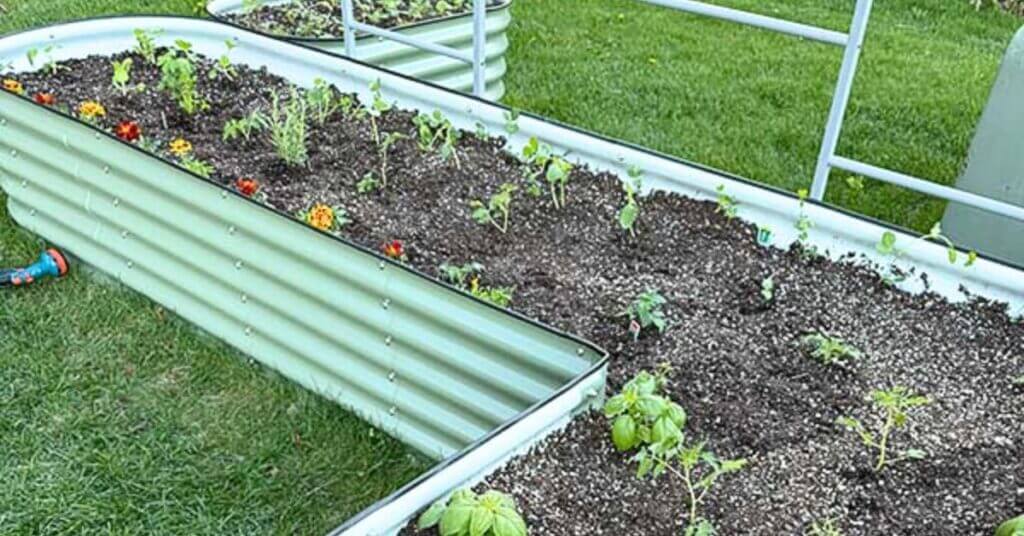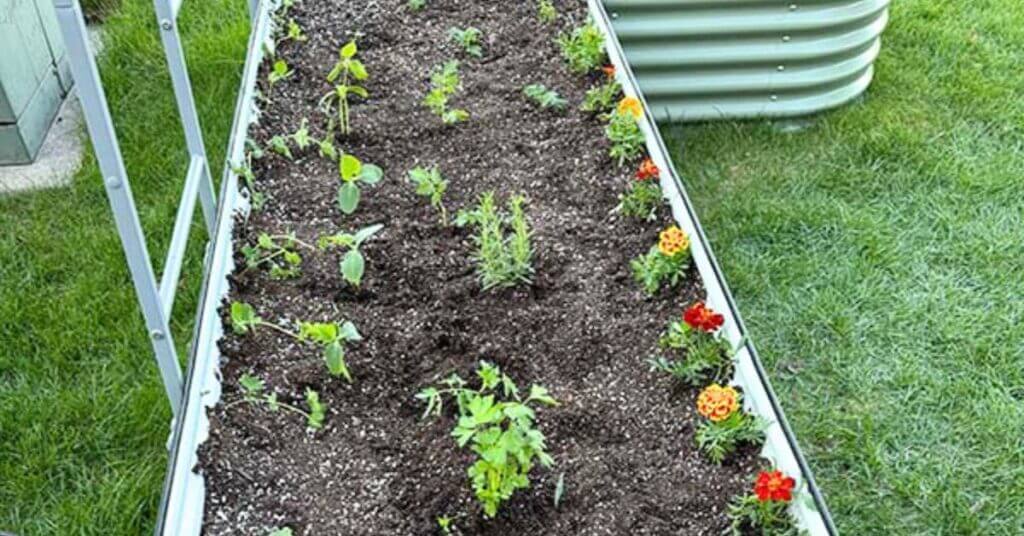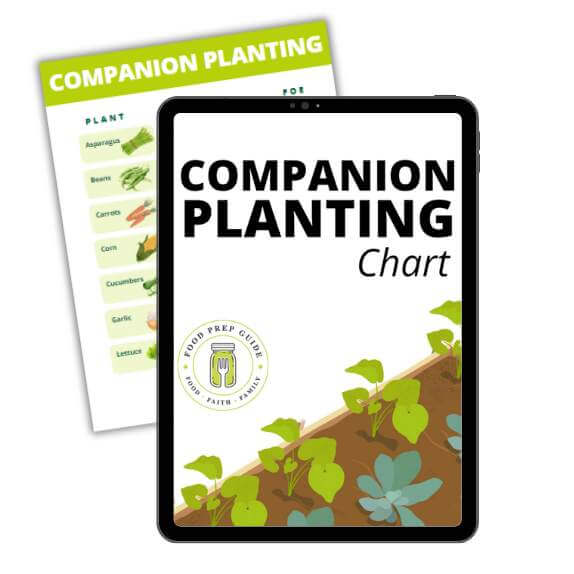Starting a raised-bed garden in suburbia seemed straightforward enough.
I had visions of fresh tomatoes, crisp cucumbers, and aromatic herbs just steps from my kitchen door. What I didn’t expect was to become a reluctant expert on tiny pests that leave you covered in itchy welts.
If you’ve ever woken up with mysterious bites after working in your garden, you’re not alone.
Here’s how I went from confused and covered in chigger bites to successfully managing both my garden and the little creatures that come with it!
The Mystery Begins
It started like something out of a detective novel. I woke up one morning to find mysterious red welts with blisters in the middle covering my arms and legs.

The itching was unbearable, and I had no idea what had attacked me in the night.
My first suspect? Bed bugs.
I’d recently stayed in a college dorm and brought my own pillow, so it seemed like a reasonable culprit. I turned my bedroom upside down looking for evidence but found nothing.
No telltale signs, no blood spots, no bugs hiding in the mattress seams.
Next, I considered fleas from our cat.
I’d noticed him scratching a few days earlier, but he’d stopped and showed no signs of infestation. Another dead end.
The Garden Connection
Thank goodness for my husband’s detective skills. He pointed out that I’d been spending a lot of time working in our raised-bed garden lately—a new variable in my routine.
This clue became even more significant when my friend Lori reported similar bites.
She’d actually felt something bite her while sitting in bed, though like me, she found no evidence of the perpetrator.
Still puzzled but determined to keep gardening, I continued my evening work sessions in the raised beds. And sure enough, I kept waking up with fresh bites each morning.

REMOVE THE GUESSWORK FROM GARDENING!
These garden plans include 10 themed garden blueprints—complete with beneficial pairings, proper spacing & more!
The Chigger Revelation
The breakthrough came when I learned that chigger bites appear hours after the actual bite occurs.
Since I was working in the garden during evening hours, it made perfect sense that the bites would show up the next morning.
The source of my chigger problem became clear: our mower couldn’t get close enough to the raised beds, leaving tufts of tall grass around the perimeter—perfect chigger habitat.
Battle Plans and Equipment Failures
We have a temperamental gas-powered weed trimmer that I’ve never mastered, so I started researching user-friendly alternatives.
I settled on a battery-powered unit that seemed perfect for non-mechanical gardeners like myself.
Prices pulled from the Amazon Product Advertising API on:
Product prices and availability are accurate as of the date/time indicated and are subject to change. Any price and availability information displayed on [relevant Amazon Site(s), as applicable] at the time of purchase will apply to the purchase of this product.
But my husband made a good point—a weed eater might damage the surface of our raised bed. So he took matters into his own hands, going out with clippers to manually trim the grass around the perimeter.
The next morning? He had four fresh chigger bites.
Now we both understood why professional landscapers and farmers wear protective gear!
Suiting Up for Garden Warfare
I quickly developed a comprehensive battle plan that includes:
Protective Clothing:
- Overalls for full leg protection
- Tightly woven denim shirt tucked securely into the overalls
- Garden boots (that had been sitting unused in my closet)
Prices pulled from the Amazon Product Advertising API on:
Product prices and availability are accurate as of the date/time indicated and are subject to change. Any price and availability information displayed on [relevant Amazon Site(s), as applicable] at the time of purchase will apply to the purchase of this product.
Treatment and Prevention:
- Chiggerex for bite relief (that was Jordan’s recommendation)
- Diatomaceous earth sprinkled around the raised bed perimeter (though it needs reapplication after watering)
- Avon’s Skin So Soft lotion and bug spray (I’ve heard great things about this for years)
- A homemade essential oil blend using peppermint, clove, eucalyptus, and lavender
Prices pulled from the Amazon Product Advertising API on:
Product prices and availability are accurate as of the date/time indicated and are subject to change. Any price and availability information displayed on [relevant Amazon Site(s), as applicable] at the time of purchase will apply to the purchase of this product.
Prices pulled from the Amazon Product Advertising API on:
Product prices and availability are accurate as of the date/time indicated and are subject to change. Any price and availability information displayed on [relevant Amazon Site(s), as applicable] at the time of purchase will apply to the purchase of this product.
The Rewards of Persistence
Despite the chigger challenges, my garden has been incredibly rewarding. I’ve already harvested five delicious cucumbers, taking the advice to pick them small before they become seedy and tough—they’ve been absolutely superb!
Prices pulled from the Amazon Product Advertising API on:
Product prices and availability are accurate as of the date/time indicated and are subject to change. Any price and availability information displayed on [relevant Amazon Site(s), as applicable] at the time of purchase will apply to the purchase of this product.
Fresh herbs have transformed our meals. I’ve been adding chopped garden mint, parsley, and basil to salads and iron skillet dishes. The mint is particularly amazing and adds such fresh flavor to everything.
Garden Success Stories
My strawberry plants are loaded with flowers and developing berries (I’m curious to see if they’ll grow larger once they turn red).
The tomato plants are thriving after aggressive pruning, and despite being planted close together, there is excellent airflow in the first six inches.
The cucumber plants are so vigorous they’re trying to take over the cantaloupe space—it’s hard to tell their flowers apart!
If all the flowers develop into fruit, we’re going to have quite a harvest.
For tomato support, I’m using an adaptable Lego-like system that’s been easy to install and expand as the plants grow. It’s working beautifully and can be modified as needed.
Prices pulled from the Amazon Product Advertising API on:
Product prices and availability are accurate as of the date/time indicated and are subject to change. Any price and availability information displayed on [relevant Amazon Site(s), as applicable] at the time of purchase will apply to the purchase of this product.
Why I Chose Vego Raised Beds
One of the best decisions I made as a beginning gardener was investing in Vego Raised Beds. These modular systems have made suburban gardening so much more manageable.
Get $10 off at Vego with code: FOODPREPGUIDE10OFF

The quality construction means they’ll last for years, and the height makes planting, weeding, and harvesting much easier on my back.
The clean lines also look great in our suburban setting, and the modular design means I can expand my garden as my confidence grows!
Lessons from a Late-Blooming Gardener
Writing this from the perspective of someone who’s new to suburban gardening, I can honestly say the learning curve has been steep but rewarding. Every challenge—from mysterious chigger bites to plant spacing issues—has taught me something valuable.
The key has been persistence, protective gear, and learning from each mistake. Did I mention how much I love these boots?
Prices pulled from the Amazon Product Advertising API on:
Product prices and availability are accurate as of the date/time indicated and are subject to change. Any price and availability information displayed on [relevant Amazon Site(s), as applicable] at the time of purchase will apply to the purchase of this product.
With guidance from experienced gardeners (like Jordan!), I’m discovering that suburban raised-bed gardening is absolutely achievable, even for beginners.
The fresh produce, herbs, and sense of accomplishment make every chigger bite worth it—though I’m definitely sticking to my protective clothing routine from now on!

















